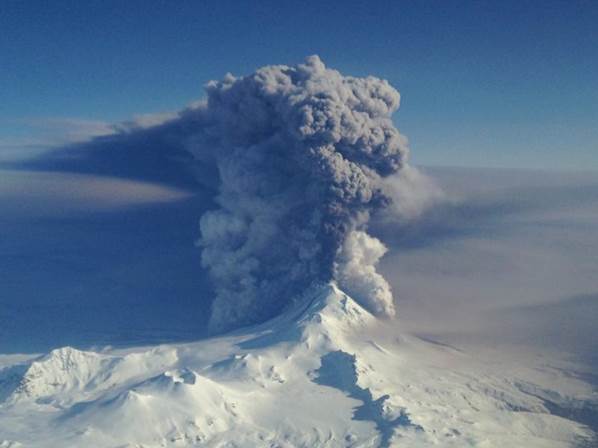When volcanoes erupt explosively, they can hurl huge ash plumes of fine (<2 mm) glassy and jagged rock and mineral fragments into the atmosphere. The smallest of these ash particles, less than 200 micrometers across, can travel hundreds of kilometers through the sky and endanger jet aircraft that fly into them. How much of an aviation hazard a specific volcanic plume presents depends not just on the concentration and particle size of the ash but also its chemical composition, according to a report in Acta Materialia (May 1, 2016). See also: Risk assessment and management; Volcano; Volcanology

Atmospheric ash plumes can be damaging to aircraft jet engines because the particles taken into the engine can partially melt and adhere to the gas-turbine blades. They can also abrade or clog other critical parts. In the worst cases, these damaging effects can cause engine flameout (failure) and a loss of power. See also: Air transportation; Aircraft propulsion; Gas turbine; Turbine engine subsystems
To investigate the adhesion properties of volcanic ash, the researchers collected samples of ash from four volcanoes in Iceland and analyzed their chemical composition. The analyzed samples fell evenly into two groups: ones that had higher silicon content and the others that had higher levels of lower-valence cations, such as calcium (Ca2+), magnesium (Mg2+), and iron (Fe2+). See also: Ion; Molecular adhesion; Silicon
The ash samples were pulverized using a ball mill and sieved to 5–50 micrometers, which is considered the most dangerous particle size. In experiments, the four ash samples were accelerated through a simulated combustion chamber onto a solid surface to determine their adhesion properties. The samples with higher levels of lower-valence cations adhered more because the cations reduced the melt viscosity of the ash. That finding suggests the risk of deposition from volcanic ash on aircraft engine parts is linked to the chemical composition. See also: Crushing and pulverizing; Particulates; Screening; Viscosity
To date, even when aircraft have lost power to all engines after encountering volcanic plumes, the pilots have been able to restart at least some of the engines and land safely. That recovery is possible because after flameout, an engine cools as the aircraft descends and the deposited ash becomes very glassy and brittle enough to break off after a few tries to restart. Nevertheless, the researchers recommend that when volcanoes erupt, the ash plumes be sampled by drone and chemically analyzed. That information could be useful in evaluating the hazard potential for a volcanic-ash advisory for aircraft. See also: Brittleness; Uninhabited aerial vehicle (UAV)





